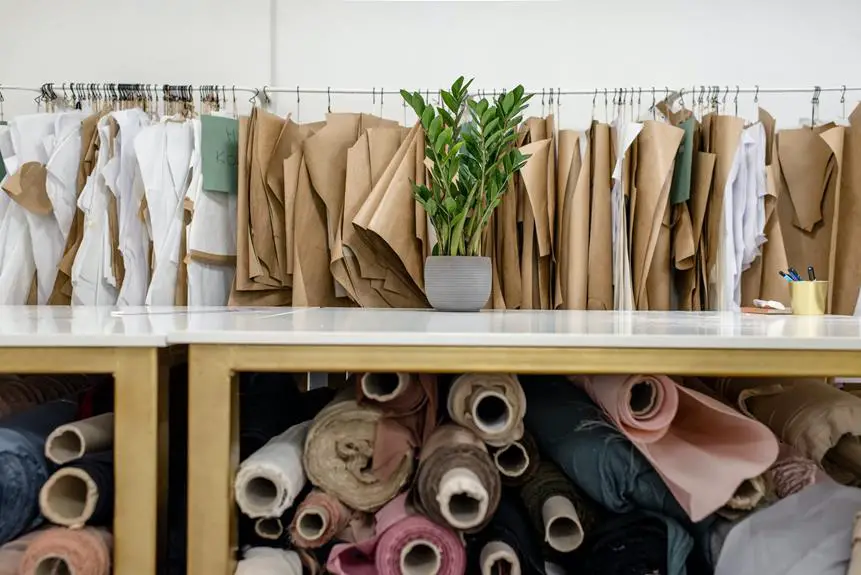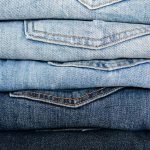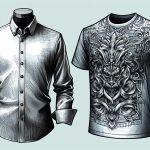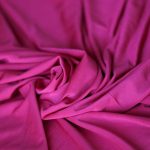So, you're trying to decide between twill and pinpoint fabric for your shirts. Both have their pros and cons, but which one comes out on top?
In this comparison, we'll delve into the characteristics of each fabric and help you determine which one best suits your needs. From weave and texture to durability and comfort, we'll break down the key factors to consider when making your choice.
By the end, you'll have a clear understanding of the differences between twill and pinpoint, and you'll be ready to make an informed decision. Let's explore the world of fabric and find out which one emerges as the ultimate winner.
Key Takeaways
- Twill fabric has a unique texture and sheen, while pinpoint fabric has a smoother texture.
- Twill fabrics can vary in weight, offering options for lightweight and heavy-duty applications, while pinpoint fabrics are generally lightweight.
- Twill fabric has a diagonal parallel rib weave, providing a sturdy yet soft and flexible feel, while pinpoint fabric has a fine, two-over, one-under pattern, resulting in a smooth and wrinkle-resistant fabric.
- Both twill and pinpoint fabrics offer comfort, breathability, durability, and styling versatility.
Fabric Characteristics
When choosing between twill and pinpoint fabrics, you'll want to consider their weave patterns and overall texture.
Twill fabric has a diagonal weave pattern, which gives it a unique texture feel and a bit of a sheen. This type of construction also makes twill fabric drape beautifully, creating a fluid and elegant look when used for garments.
On the other hand, pinpoint fabric has a finer, tighter weave, resulting in a smoother texture feel and a crisper drape.
It's also important to consider fabric weight when comparing these two. Twill fabrics can vary in weight, offering options for both lightweight and heavy-duty applications.
Pinpoint fabrics, while generally lightweight, can also be found in slightly heavier variants, providing versatility for different clothing styles and preferences.
Understanding these fabric characteristics will help you make an informed decision based on the specific drape, texture feel, and fabric weight you desire for your project.
Weave and Texture
Consider the weave patterns and overall texture of twill and pinpoint fabrics when deciding which one best suits your needs.
Twill fabric is known for its diagonal parallel ribs, which create a distinctive texture and drape. This weaving technique gives twill a sturdy, substantial feel while remaining soft and flexible.
On the other hand, pinpoint weave is characterized by a fine, two-over, one-under pattern that results in a smooth and wrinkle-resistant fabric with a subtle sheen.
- Twill texture provides depth and dimension, making it an excellent choice for structured garments like suits and jackets. The diagonal lines add visual interest and make the fabric more forgiving when it comes to wrinkles and creases.
- Pinpoint weave, with its fine and densely woven texture, offers a polished and formal appearance, making it ideal for dress shirts and professional attire. The smooth surface lends itself well to crisp collars and a neat, tailored look.
- When comparing weave and texture, consider the desired end use of the fabric. Twill's textured finish may be favored for casual and semi-formal wear, while pinpoint's smooth surface is well-suited for formal and business attire.
Durability and Longevity
To gauge the durability and longevity of twill and pinpoint fabrics, you should factor in how they hold up to frequent wear and laundering. Durability testing is crucial in determining how well a fabric can withstand everyday use and the rigors of washing. Additionally, fabric aging is a key consideration since you want a fabric that will maintain its quality and appearance over time. When comparing twill and pinpoint fabrics in terms of durability and longevity, it's essential to understand how they perform in these areas.
To give you a clearer picture, here's a comparison table:
| Aspect | Twill Fabric | Pinpoint Fabric |
|---|---|---|
| Durability | Known for its strength and resilience | Offers good resistance to wear and tear |
| Longevity | Holds up well over time | Maintains quality through repeated use |
| Fabric Aging | Shows minimal signs of aging | Retains its appearance even with frequent use |
As you can see, both twill and pinpoint fabrics demonstrate strong durability and longevity. However, twill fabric may have a slight edge in terms of strength, while pinpoint fabric excels in maintaining its quality over time.
Comfort and Breathability
In assessing the comfort and breathability of twill and pinpoint fabrics, you'll find that their durability and longevity directly impact how they feel and perform in daily wear.
When it comes to comfort, both twill and pinpoint fabrics offer a soft and smooth texture, making them pleasant to wear throughout the day. The softness of the fabric contributes to a comfortable feel against your skin, ensuring that you can go about your day without any discomfort.
Additionally, both fabrics are adept at moisture wicking, which means they can effectively draw sweat away from your body, keeping you feeling dry and comfortable.
- Softness: Both twill and pinpoint fabrics offer a soft and smooth texture, contributing to a comfortable feel against your skin.
- Moisture Wicking: These fabrics are adept at drawing sweat away from your body, keeping you feeling dry and comfortable throughout the day.
- Breathability: Both twill and pinpoint fabrics allow for adequate airflow, ensuring that you stay cool and comfortable, even in warmer weather.
These characteristics make twill and pinpoint fabrics excellent choices for those who prioritize comfort and breathability in their clothing.
Styling Versatility
When it comes to styling versatility, both twill and pinpoint fabrics offer a range of options for creating diverse and fashionable looks. Twill fabric is known for its diagonal weave pattern, providing a textured appearance that adds depth to any outfit. On the other hand, pinpoint fabric features a finer weave, giving it a smoother and more formal look. Let's delve into the styling options and fashion flexibility offered by these two fabrics.
| Styling Options | Twill Fabric | Pinpoint Fabric |
|---|---|---|
| Formal Wear | ✔️ | ✔️ |
| Casual Wear | ✔️ | ✔️ |
| Layering | ✔️ | ✔️ |
Twill and pinpoint fabrics both excel in offering versatile styling options. Whether you're aiming for a formal, business-appropriate look or a more relaxed, casual ensemble, both fabrics have got you covered. Additionally, their compatibility with layering makes them suitable for various weather conditions and allows for creative outfit combinations. The fashion flexibility provided by twill and pinpoint fabrics makes them essential components of a well-rounded wardrobe, ensuring you can effortlessly transition from a professional setting to a social gathering with style and ease.
Color and Pattern Options
When it comes to color and pattern options, both twill and pinpoint fabrics offer a wide range of choices to suit your personal style. You'll find a multitude of colors to match any outfit or occasion, from classic neutrals to vibrant hues.
Additionally, the pattern diversity of both fabrics allows you to express your individuality, whether you prefer traditional stripes or more contemporary designs.
Color Versatility
You can find a wide range of color and pattern options in both twill and pinpoint fabrics, making it easy to match your personal style and preferences.
When it comes to color matching, both twill and pinpoint fabrics offer a diverse selection, allowing you to find the perfect hue for your wardrobe. The dyeing process for these fabrics is carefully executed, resulting in vibrant and long-lasting colors that won't fade easily.
Whether you prefer classic solid colors, subtle stripes, or bold patterns, both twill and pinpoint fabrics have you covered. Additionally, these fabrics are available in an array of seasonal shades, ensuring you can stay on-trend throughout the year.
Pattern Diversity
The pattern diversity in both twill and pinpoint fabrics allows for a wide range of color and design options, catering to your personal style and preferences.
Twill fabric offers a versatile canvas for a variety of patterns, from classic stripes and checks to more intricate designs, making it a great choice for those who appreciate fabric versatility and design options.
On the other hand, pinpoint fabric provides a crisp and clean look, with a finer texture that complements a range of patterns, including traditional gingham and subtle herringbone.
Whether you prefer bold and vibrant colors or more subdued hues, both twill and pinpoint fabrics offer an extensive selection of pattern variety and fabric options to suit your individual taste and garment needs.
Maintenance and Care
To ensure the longevity of your twill or pinpoint fabric garments, it's important to follow proper maintenance and care guidelines. Both twill and pinpoint fabrics require special attention when it comes to cleaning and care due to their fabric sensitivity.
Here are some tips to help you maintain your twill or pinpoint garments in top condition:
- Gentle Washing: Always use a gentle washing method to protect the delicate fibers of twill and pinpoint fabrics. Opt for a mild detergent and avoid harsh chemicals that can damage the fabric.
- Avoid High Heat: When it comes to drying your twill or pinpoint garments, avoid high heat. Opt for air drying or use the lowest heat setting on your dryer to prevent shrinkage and preserve the fabric's integrity.
- Proper Storage: Store your twill and pinpoint garments in a cool, dry place away from direct sunlight to prevent fading and discoloration. Additionally, consider using garment bags to protect them from dust and moisture.
Price and Value
When considering the price and value of twill and pinpoint fabrics, it's important to assess their long-term durability and versatility.
Twill is generally priced slightly higher than pinpoint due to its intricate weaving pattern and thicker yarns. However, this price difference is often justified by twill's exceptional durability and ability to resist wrinkles, making it a cost-effective choice in the long run.
Pinpoint, on the other hand, offers a more budget-friendly option without compromising on quality. Despite being lighter in weight, pinpoint fabric maintains its crispness and smooth appearance, providing excellent value for its price.
In terms of quality assessment, twill fabric's higher thread count and characteristic diagonal weave contribute to its superior strength and resilience, ensuring that garments made from twill last for a considerable amount of time. Pinpoint, while more affordable, still boasts a high-quality construction that withstands regular wear and washing.
Both fabrics offer distinct advantages in terms of price and value, allowing you to make an informed decision based on your budget and long-term clothing needs.
Frequently Asked Questions
Can Twill and Pinpoint Fabrics Be Used for Outdoor or Athletic Wear?
Yes, both twill and pinpoint fabrics can be used for outdoor or athletic wear. They offer durability and breathability, making them great for outdoor performance and athletic functionality. Plus, they provide a comfortable and stylish option for your active lifestyle.
Are There Any Specific Environmental Considerations for Twill and Pinpoint Fabrics?
When considering environmental impact, sustainability, and eco-friendly dyeing techniques, it's essential to examine fabric production. Understanding these factors can help you make informed choices about the eco-friendliness of twill and pinpoint fabrics.
How Do Twill and Pinpoint Fabrics Perform in Terms of Moisture-Wicking and Odor-Resistance?
When it comes to moisture-wicking, odor-resistance, durability, and breathability, both twill and pinpoint fabrics perform admirably. They keep you dry, fresh, and comfortable, making them excellent choices for various clothing items.
What Are the Best Ways to Repair or Mend Twill and Pinpoint Fabrics if They Become Damaged?
If you want to mend twill or pinpoint fabrics, there are various repair methods you can use, depending on the type of damage. Both fabrics are durable, making them ideal for patching and stitching.
Are There Any Special Considerations for Dyeing or Printing on Twill and Pinpoint Fabrics?
When it comes to dyeing techniques and printing methods for twill and pinpoint fabrics, it's important to consider the fabric's weave, weight, and fiber content. Different fabrics may require specific processes for optimal results.
- Does Chiffon Fabric Stink - July 15, 2025
- Does Chiffon Fabric Affect the Economy - July 15, 2025
- Does Cotton Fabric Have a Nap - July 15, 2025







